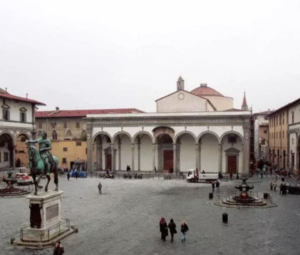March 25: Florence Celebrates its Second New Year

March 25: FLORENTINE NEW YEAR. The main event will begin at 3:15 pm this Saturday, but there is a multitude of other activities.
The history behind Florentine New Year starts in the mid-thirteenth century. From 1250 to 1750, Florence’s New Year was on March 25, the feast of the Annunciation. People could be seen coming together in the SS Annunziata to ring in the spring season and to commemorate the moment when the Angel Gabriel gave Mary the news that she would be the mother of Jesus Christ.
The Santissima Annunziata (the Most Holy Annunciation) church features a medieval fresco of the Annunciation. It is said the artist who frescoed the masterpiece fell asleep after finishing all but the face of the Virgin Mary, and when he rose from his slumber, he was astonished to see a completed blonde Madonna – seemingly done by angels from above. The fresco can be found to the left of the entrance on the inner wall of the church.
The Gregorian calendar, which starts in January and ends in December, that most people around the world follow today, was introduced in 1582. In disapproval of the new almanac, the Florentines waited 168 years, until 1750, to adopt the Gregorian calendar year in hopes of preserving the exceptionality of the Annunciation. March 25 continues to mark a new year in Florence and is celebrated annually; exactly nine months before the birth of Jesus on Christmas.
This Saturday, the historical procession of Florentine New Year, the traditional parade that will commence a quarter after 3 pm, will start in Parte Guelfa Square and move through via Pellicceria, piazza della Repubblica, via de’ Brunelleschi, via de’ Pecori, piazza San Giovanni, piazza del Duomo, via de’ Servi and will end in piazza Santissima Annunziata. The parade will feature individuals in the historical outfit of the Florentine Republic. At 4 pm, the procession will enter the Basilica of SS. Annunziata and people will pay their respects to the ancient and sacred fresco of the Annunciation. After homage is paid, the procession will head back to Parte Guelfa, following a route from via de’ Servi, to piazza del Duomo, to via de’ Calzaiuoli, to via Porta Rossa and via Pellicceria.
The home of the ‘Brindellone’ will be open for visiting from 10 am to 4 pm on March 25. A 32-foot-tall wagon, shaped like a tower and sacred to Florentines, the ‘Brindellone’ is part of an ancient Easter tradition in Florence called Scoppio del Carro (Explosion of the Cart) and was made in 1765. Stored in a warehouse in Via il Prato 48 during the year, fireworks wired on the the more than four-ton cart explode after the flight of the dove from the Cathedral on Easter morning. The cart is pulled by two, elegantly decorated white oxen to Piazza del Duomo beforehand.
Along with the procession and visiting the ‘Brindellone’, there will be free guided tours through Palazzo Vecchio on Saturday and Sunday for adults called “Traces of Florence” at 10:30 am, 11:30 am and 12:30 pm. Kids will be able to participate in a fairy tale called “To build a city you need a flower” at 10 am, 11 am and 12 noon. At 2:45 and 4:15 pm, guests will be able to “meet” Anna Luisa de’ Medici. Reservations for all the above events must be made in advance by emailing info@musefirenze.it or calling 055-2768224. While there is free entrance to all activities, admission to Palazzo Vecchio is €12,50, excluding access to the current exhibition.
Torre della Zecca, open on Saturday for visits on the hour from 3 to 6 pm by reservation only, was one of Florence’s defense towers. Previously surrounded by homes and other buildings, the tower now stands alone and looks over the Arno River.
Yet another event on March 25 will be a walk along the walls from Porta San Giorgio, a gate hidden away in an olive grove used to keep watch on the outside of the ancient walls of Florence; to Piazzale Michelangelo, a square located in the Oltrarno district with its panoramic view of Florence. Sunday, March 26 will feature visits at Porta Romana, another ancient gate apart of the ancient walls of Florence. Created in 1330, the so-called “door” is the best-preserved and largest in the city.
Piazza Santa Maria Novella will be hosting a Florentine New Year exhibition market that will have 30 vendors showcasing their artistic work and agricultural products; available from 10 am to 7 pm. The Santissima Annunziata fair will also take place, featuring food and crafts along with the famous brigidini: large, crunchy yellow aniseed-flavored wafers from the province of Pistoia. The fair will be open from 8 am to 8 pm.
Patrons can find the “Cassettai fiorentini” – vendors of ancient crafts and souvenirs of Florence – and if the phrase “Fiorentino New Year 1750” is said, visitors will be gifted a “Florentina,” a Florentine bar of soap that has been handmade in the city since 1894. (Parker Hurley)
